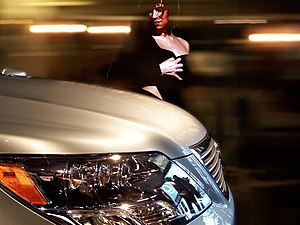 Everyone pays attention to what the local gas stations/convenience stores are charging in their area, would be foolish NOT to do that. I ended up in a conversation with a friend about it, but had to use a spreadsheet to explain it as one of darn "math word problems." Here it is (and my results).
Everyone pays attention to what the local gas stations/convenience stores are charging in their area, would be foolish NOT to do that. I ended up in a conversation with a friend about it, but had to use a spreadsheet to explain it as one of darn "math word problems." Here it is (and my results).Math Problem
Bob drives a company car that gets 30 miles per gallon. He drives 36 miles per day Monday through Friday, to and from work. He passes a station on the way both ways, that is currently charging $3.75 per gallon. He heard about another station that is 2 miles past his office that is charging $3.72 per gallon. He decides on his lunch hour, to go there and fill up. How much did he save?
Solution
He didn't, it cost him $0.21 more. WHAT?!? HOW?!? Using the same 30 MPG car at each station it breaks down like this:
- Stopping at the station on the way home from work, that day he drove 36 miles
- Cost of gas per gallon is $3.75, cost per mile is $0.125 ($ per gallon / 30 mpg)
- Cost of the daily drive (cost per mile X miles) = $4.50
- Going to the station that was farther from work, that day he drove 38 miles
- 2 miles back, plus the 36 to and from work
- Only added 2 miles to get back from the station because he used his existing gas to get there in the first place.
- Cost per gallon of gas is $3.72, cost per mile is $0.124 ($ per gallon / 30 mpg)
- Cost of the daily drive (cost per mile X miles) = $4.71
- Savings? Loss of $0.21
So, financially he lost $0.21 that day, but expand it to a monthly comparison. Same company car, same stations, Monday through Friday mileage, same cost per gallon.
- Stopping at the station on the way home from work, that month he drove 720 miles
- 36 miles per day X 5 days per week X 4 weeks in the month
- Cost of gas per gallon is $3.75, cost per mile is $0.125 ($ per gallon / 30 mpg)
- Cost of the monthly drive (cost per mile X miles) = $90.00
- Going to the station that was farther from work, that month he drove 800 miles
- Cost per gallon of gas is $3.72, cost per mile is $0.124 ($ per gallon / 30 mpg)
- Cost of the monthly drive (cost per mile X miles) = $99.20
- Savings? Loss of $9.20
I admire business managers for figuring out how to better the bottom line by combining several profit revenues together, and blending it with marketing. Shows that business people are finally waking up on how to better the ROI.
I'm just trying to share with everyone what you need to "consider" on where you go to purchase what you need and better your wallet...














